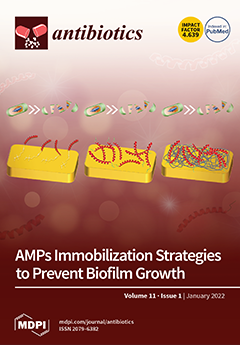Staphylococcus aureus (
S. aureus) infections, particularly methicillin-resistant
Staphylococcus aureus (MRSA) in humans and animals, have become a significant concern globally. The present study aimed to determine the prevalence and antibiogram of
S. aureus isolated from animal handlers in Peninsular Malaysia. Furthermore,
[...] Read more.
Staphylococcus aureus (
S. aureus) infections, particularly methicillin-resistant
Staphylococcus aureus (MRSA) in humans and animals, have become a significant concern globally. The present study aimed to determine the prevalence and antibiogram of
S. aureus isolated from animal handlers in Peninsular Malaysia. Furthermore, the genotypic characteristics of
S. aureus isolates were also investigated. Nasal and oral swab samples were collected from 423 animal handlers in Peninsular Malaysia. The antibiogram profiles of
S. aureus against 18 antibiotics were established using a Kirby–Bauer test. The genotypic profile of
S. aureus, including the presence of antimicrobial resistance (AMR), virulence genes and
spa genotypes, was investigated using molecular techniques. The overall carriage rate of
S. aureus, MRSA and MDRSA was 30.5%, 1.2% and 19.4%, respectively.
S. aureus was highly resistant against penicillin (72.3%) and amoxicillin (52.3%). Meanwhile, gentamicin and linezolid were fully effective against all the isolated
S. aureus from animal handlers. It was observed that animal handlers with close exposure to poultry were more likely to carry
S. aureus that is resistant to tetracycline and erythromycin.
S. aureus isolates harboured tetracycline resistance (
tetK,
tetL and
tetM), erythromycin resistance (
ermA,
ermB,
ermC and
msrA) and immune evasion cluster (IEC) genes (
scn,
chp,
sak, sea and
sep). Seventeen different
spa types were detected among the 30 isolates of MDRSA, with t189 (16.7%) and t4171 (16.7%) being the predominant
spa type, suggesting wide genetic diversity of the MDRSA isolates. The present study demonstrated the prevalence of
S. aureus strains, including MRSA and MDRSA with various antimicrobial resistance and genetic profiles from animal handlers in Peninsular Malaysia.
Full article






